Levofloxacin 500 - antibioticused in the treatment of a number of bacterial infections. Doctors recommend using pills when other drugs have no effect. In pharmacies, the medicine is offered at affordable prices.
Record content:
- 1 Form of release and composition of the drug Levofloxacin 500
- 2 Pharmacological properties
- 3 Pharmacodynamics and pharmacokinetics
- 4 Indications for use
- 5 Contraindications
- 6 At what age can tablets be used?
- 7 Instructions for use, dosage
- 8 Side effects
- 9 Overdose
- 10 special instructions
- 11 Drug interactions
- 12 Analogs
- 13 Terms, conditions of sale and storage
- 14 Price in pharmacies in Moscow, St. Petersburg, regions
- 15 Video about the drug Levofloxacin
Form of release and composition of the drug Levofloxacin 500
Manufacturers release the drug in various forms:
- Eye drops, which contain 1 ml of a 0.5% solution.
- Solution for preparation of infusions.
- Tablets containing 256.23 or 512.48 mg of the main active ingredient.
The tablet form, registered under the name Levofloxacin 500, contains the active substance levofloxacin hemihydrate.
Tablet, 500 mg, includes, in addition to the active ingredient, auxiliary ingredients:
- hypromellose 17.99 mg;
- microcrystalline cellulose 61.65 mg;
- calcium stearate 6.3 mg;
- polysorbate 3.2 mg.
The tablets are film-coated, biconvex, round, yellowish. In the cross section, two layers are clearly visible.
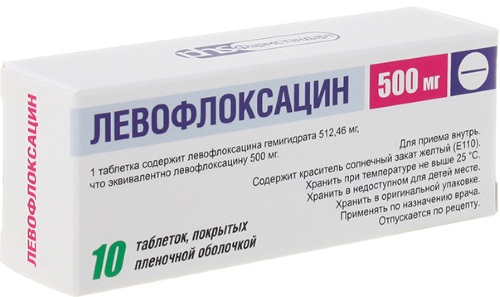
The shell consists of the following substances:
- hypromellose, 15 mg;
- titanium dioxide, 3.25 mg;
- hyprolosis, 5.83 mg;
- talc, 5.77 mg;
- dry mix included in the film coating, 19%;
- yellow oxide, 31 mg.
Levofloxacin 500 - tablets, the price of which is affordable for buyers. They are soldered into contour cells, consisting of 5, 7 or 10 sockets. The drug is sold in cardboard boxes.
Pharmacological properties
Levofloxacin is an antibiotic that stops the growth of bacteria by preventing reproduction and repair of their genetic material, DNA. The drug belongs to a class of antibiotics called fluoroquinolones. The substance levofloxacin belongs to the third generation of drugs in this group, and is active against many gram-negative and gram-positive bacteria.
Fluoroquinolone antibiotics can cause serious side effects.
Levofloxacin 500 - tablets, the price of which does not exceed 500 rubles. They should only be used for infections that cannot be treated with a safer antibiotic.
Pharmacodynamics and pharmacokinetics
The antimicrobial spectrum is wide and includes:
- gram-positive cocci: Staphilococcus aureus and Staphilococcus epidermidis (methicillin-susceptible strains); streptococcus is less sensitive;
- gram-negative: Neisseria gonorrhoeae, Neisseria meningitidis;
- gram-negative bacilli: Escherichia coli, Salmonella, Shigella, H. influenzae, Moraxella, Legionella, Pseudomonas aeruginosa;
- chlamydia: Chlamidia trachomatis;
- mnycoplasme: Mycoplasma pneumoniae;
- mycobacteria: Mycobacterium tuberculosis, M fortuitum, M. kansasii, moderately sensitive.
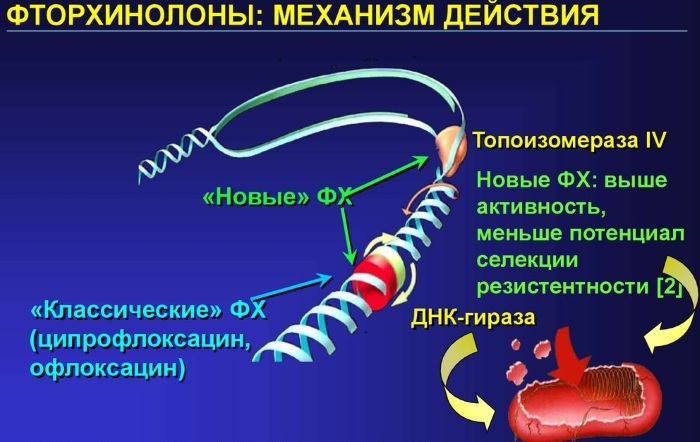
The drugs of the third group of fluoroquinolones, to which Levofloxacin belongs, effectively resist atypical pathogens.
The mechanism of bactericidal action occurs by inhibiting bacterial tyrase DNA present in bacteria. Resistance is established slowly, with a low frequency, by spontaneous chromosome mutations.
In this case, the mechanical energy available in the chromosome of bacteria decreases, and the length of the chromosome increases. As a result, the bacterial DNA cannot be reproduced correctly. First, the bacteriostatic effect occurs, in which the growth of the bacteria stops, and then the cells die and thus the bactericidal effect occurs.
Orally administered drug has good bioavailability, 95-100%. The absorption rate does not depend on food intake.
The drug implements 40% plasma concentration. High concentrations are achieved more in the kidneys, prostate, liver, lungs, glomeruli, bones than in plasma, which indicates a good penetration of the drug into the body systems.
Excretion occurs primarily through liver metabolism. The renal part is eliminated proportionally, decreases unchanged. Average T½ is 9.5 hours. Plasma protein binding is average. It has a large volume of distribution due to its good diffusion in the tissue.
Indications for use
The medication is taken in the following cases:
- uncomplicated urinary tract infections;
- pneumonia, which is treated at home;
- gonococcal urethritis;
- chronic bronchitis during an exacerbation;
- digestive infections (traveler's diarrhea, gastroenteritis with salmonella, acute bacterial dysentery);
- typhoid fever:
- osteomyelitis;
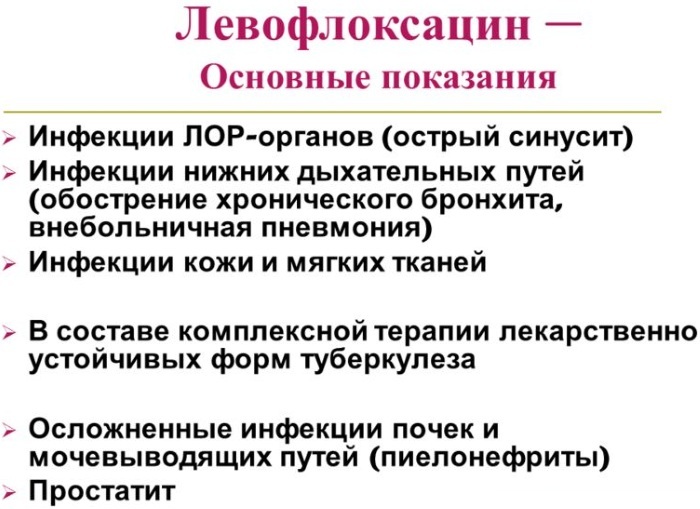
- uncomplicated skin infections, soft tissue infections.
Contraindications
Some medicines are not suitable for people with certain medical conditions and are sometimes used with extreme caution.
For these reasons, before you start taking levofloxacin, it is important to know that the drug is contraindicated:
- Pregnant women, breastfeeding women.
- Children and adolescents under 18 years of age.
- Patients with severe renal impairment.
- People with individual intolerance to drugs of the quinolone group: norfloxacin, ofloxacin, ciprofloxacin, moxifloxacin and nalidixic acid.
- Those who have hypersensitivity to the components of the drug.
- Suffering from epilepsy or other conditions that cause seizures.
- If there has ever been a problem with a tendon, such as tendonitis.
- With diabetes mellitus.
The drug should be taken with caution:
- If ever had a mental health problem.
- If in the past there was a condition that caused fatigue and muscle weakness, myasthenia gravis.
- In case of problems with the liver.
- With heart disease, frequent palpitations.
- With a deficiency of glucose-6-phosphate dehydrogenase.
- If any other medications are being taken.
At what age can tablets be used?
The tablets can be taken from the age of 18.
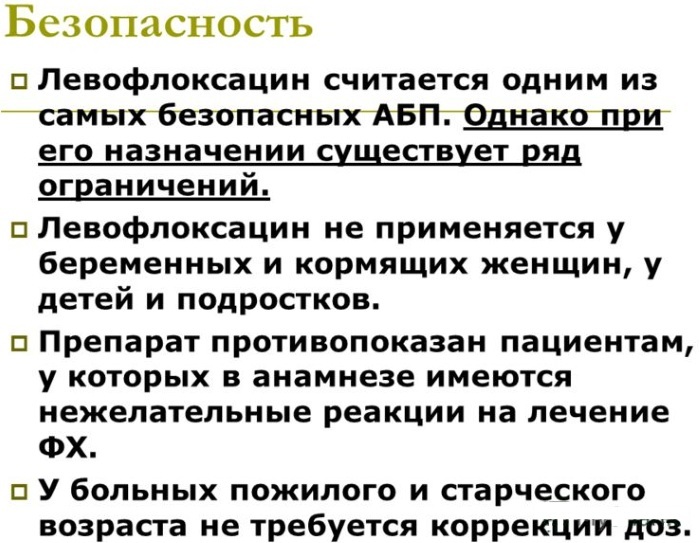
Until this age, children are likely to develop articular cartilage damage if the medication is taken.
Instructions for use, dosage
Levofloxacin 500 - tablets, the price of which is quite affordable.
They are taken for the following diseases:
- uncomplicated urinary tract infections, 100-250 mg 2 times / day for 3-4 days; for complicated infections 100-500 mg 2 times / day for 7-14 days;
- gonococcal urethritis 100-500 mg as a single dose;
- digestive infections (traveler's diarrhea, gastroenteritis with salmonella, acute bacterial dysentery) 500 mg 2 times / day for 5 days;
- typhoid fever: 500 mg 2 times / day for 7-14 days;
- osteomyelitis 750 mg 2 times / day for 2 months;
- uncomplicated skin infections 750 mg 2 times / day for 10 days.
- acute sinusitis, once a day, 500 mg, for 10-14 days.
How to take levofloxacin:
- Take levofloxacin exactly as directed by your doctor.
- The usual dose is 500 mg per day, although a dose of 250 mg per day is sufficient for some infections, while others require 400 or 500 mg twice a day.
- The tablets can be taken before or after meals. If only one dose per day is being taken, it is advisable to take it in the morning. If more than one dose is taken per day, then the dosages should be distributed, it is better to take the medicine every 12 hours.
- The drug should be taken with a sufficient amount of water. If necessary, you can split the pill in half along the lines, but you cannot crush or chew them.
- It is advisable to drink several glasses of water during the day. Additional drinking prevents the unwanted effects of levofloxacin. This medicine works best if there is a constant amount of fluid in the blood.
- If the dose has been missed in time, you can take the pill at any time, but you cannot take a double dose.
If you feel better, you should continue to take the antibiotic until the end of the course. This is necessary to prevent relapse. The course of treatment usually lasts 7-14 days. If the state of health has not improved after the end of the course, you should consult a doctor.
The drug is taken in the next 48 hours after the normalization of all symptoms of the disease or after laboratory tests confirming the healing process.
Side effects
Along with the beneficial effects, most antibiotics cause unwanted side effects, but these often go away as the body adjusts to the new drug.
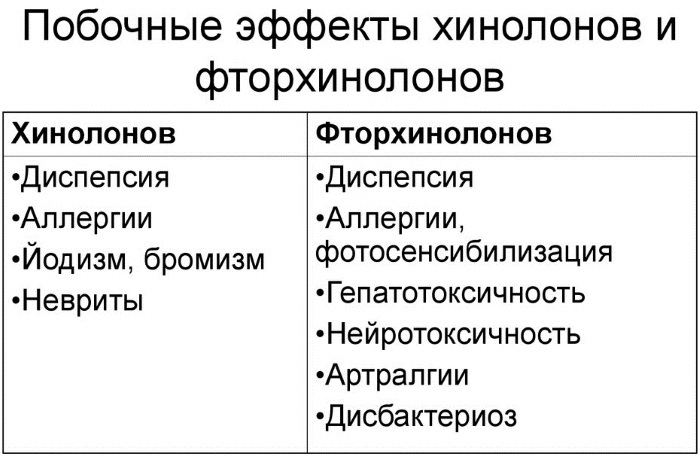
The table contains some of the most common side effects:
| Common side effects of levofloxacin | How to get rid of them |
| Feeling nauseous | Stick to simple meals, avoid fatty and spicy foods. |
| Diarrhea | Drink plenty of water to recover lost fluids. If diarrhea persists for a long time, consult a doctor. |
| Headache | Drink plenty of water, you can use light pain relievers, as agreed with your doctor. |
| Feeling dizzy | Do not drive or use power tools while the drug is being treated. |
| Sleep problems | You can drink soothing teas, drinks at night. |
| Temporary changes in liver enzymes | Taking the drug, you should monitor the liver, take tests. |
In addition to these symptoms, you may experience:
- allergic reactions in the form of a rash, swelling on the face, shortness of breath;
- joint pain;
- change in taste;
- a feeling of pain, tingling, numbness in the muscles;
- confusion of consciousness;
- changes in microflora.
Overdose
High doses of the drug are most often reflected in the action of the central nervous system. It can be dizziness, drowsiness, convulsions similar to epileptic, fainting. Often, increased doses cause disorders in the gastrointestinal tract: nausea, diarrhea, vomiting.
There are no drugs to relieve these symptoms. Removal of excess doses of the drug using dialysis is also ineffective.
special instructions
- While taking the drug, you should regularly visit your doctor to monitor adverse reactions.
- The drug triples the risk of heart attacks.
- Levofloxacin can cause the skin to become more sensitive to sunlight. You can protect it with sunscreen.
- Do not take pain relievers, non-steroidal anti-inflammatory drugs such as ibuprofen during this period.

- Some people get thrush (redness and itching in the mouth or vagina) after a course of antibiotics. If it is found, you should consult your doctor.
- This antibiotic does not work with some vaccines, for example, it may interfere with the oral typhoid vaccine.
- A decrease in doses, an increase in the interval between doses, is required for patients with creatinine clearance <50 ml / sec.
- Patients with functional disorders of the liver do not need dose reduction.
- It is not advisable to take antacids or medicines containing iron, zinc (for example, multivitamin tablets) within two hours before taking levofloxacin or within two hours after taking a dose. This is due to the fact that these drugs have a bad effect on the absorption of levofloxacin by the body.
- Levofloxacin 500 tablets are not enough for severe inflammatory lung diseases caused by pneumococci. In such cases, combined therapy is carried out, and the cost of treatment increases.
The pharmacokinetic properties of levofloxacin in young and elderly people do not differ significantly when taking into account creatinine clearance.
However, since the drug is largely excreted by the kidneys, the risk of toxic reactions to it may be higher in patients with impaired renal function. Elderly patients are more likely to have decreased renal function, so they should be careful when choosing a dose.
Drug interactions
Like any antibiotic, Levofloxacin is incompatible with some drugs:
- Cyclosporins increase the half-life of the drug.
- Glucocorticosteroids, when interacting with which there is an increased risk of tendon rupture.
- The drug is incompatible with most drugs belonging to the fluoroquinolone group, except for ciprofloxacin.
Analogs
Levofloxacin 500 - tablets (the price of analogs is not always less), which can be replaced in some cases with drugs with a similar mechanism of action.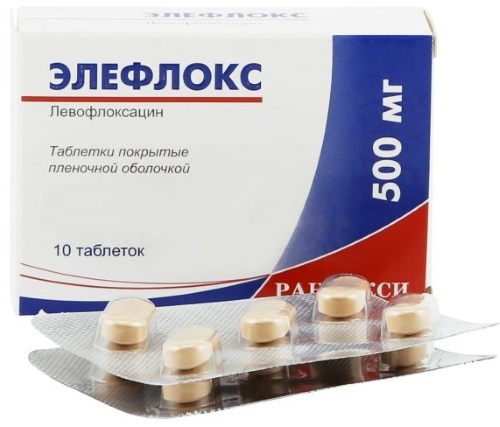
| Name |
Release form Active substance |
Application area |
Price in rubles |
| Eleflox | Tablets containing 500 mg levofloxacin | Bronchitis, community-acquired pneumonia, diseases of the ENT organs, bacterial prostatitis. | 800 |
| Lomefloxacin | Tablets containing 400 mg of lomefloxacin hydrochloride | Infectious and inflammatory diseases: urinary tract, chronic bronchitis, pulmonary tuberculosis, urogenital chlamydia. | 500 |
| Norbactin | Tablet preparation, each containing 400 mg of norfloxacin | Infectious disorders of the genital tract, travelers' diarrhea, infections in the gastrointestinal tract, uncomplicated gonococcal infection. | 200 |
| Avelox | Tablets containing 250 and 500 mg of oxyfloxacin | Infectious inflammations of ENT organs, soft tissues and skin, urogenital infections. | 600 |
| Cyprinol | Tablets of 250 and 500 mg with the active substance ciprofloxacin | Diseases caused by infections: gallbladder, respiratory, urinary tract, digestive system, mucous tissues, skin, throat, nose. | 120 |
| Nolitsin | Tablet form containing 400 mg of norfloxacin | Gastroenteritis of bacterial origin, urinary tract infections, uncomplicated gonorrhea. | 250 |
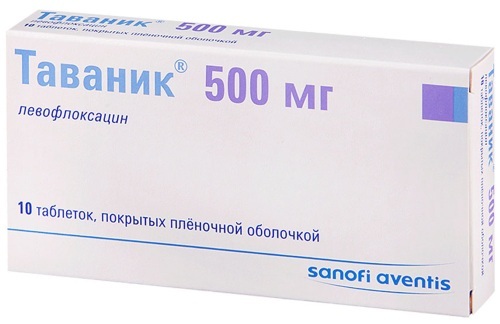
There are a large number of antibacterial drugs belonging to the group of fluoroquinolones. A doctor will always help to understand them, who will choose the right remedy, determine the acceptable dose.
Terms, conditions of sale and storage
The tablets are stored at room temperature, they do not like high humidity. Store in a safe place away from children. Shelf life is no more than 2 years. Available with a prescription.
Price in pharmacies in Moscow, St. Petersburg, regions
Levofloxacin 500 - tablets (price is targeted at the average consumer), which are available in all regional pharmacies.
The cost of a package containing 10 pcs. 500 mg of the drug:
- Moscow and the Moscow region: from 180 to 400 rubles.
- St. Petersburg: from 330 to 700 rubles.
- Chita: from 200 to 320 rubles.
- Perm: from 460 to 700 rubles.
- Elista: from 317 to 550 rubles.
- Tyumen: from 80 to 200 rubles.
- Yekaterinburg: from 315 to 534 rubles.
- Vologda: from 380 to 650 rubles.
- Bryansk: from 230 to 668 rubles.
- Krasnodar: from 110 to 750 rubles.
The range of prices depends on the manufacturer. The most expensive drug is manufactured by Teva Pharmaceutical Industries Ltd.
When deciding on the use of medications, it is always necessary to keep in mind the risks associated with taking them. The need to use antibiotics, including Levoflokassin 500 tablets, should be weighed against the benefits and safety, despite its relatively low price.
Video about the drug Levofloxacin
Doctor's opinion about Levofloxacin:



